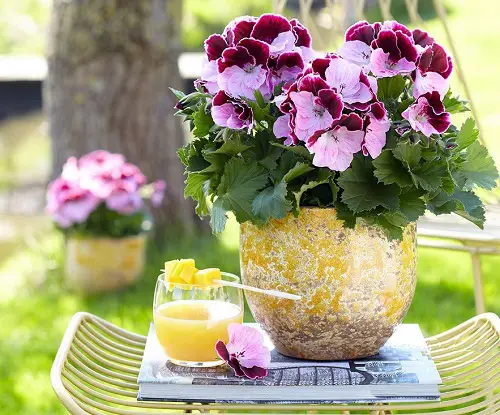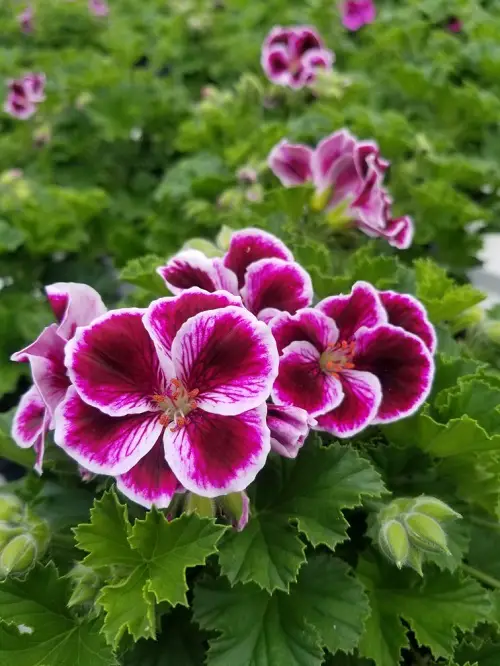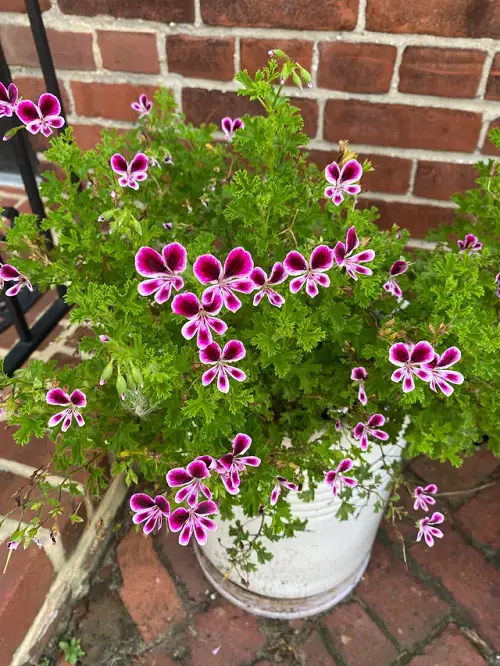Martha Washington Geranium are one of the most beautiful flowers you can grow in gardens and homes!

Martha Washington Geraniums produces vibrant and showy blooms in shades of pink, purple, and white, which make them stand out vividly from the other varieties!
Best Types of Geraniums
Martha Washington Geranium Plant Information

The Martha Washington Geranium was developed in the early 1800s and is a perennial flowering plant that has showy flowers and a long blooming period, flowering from late spring until fall.
The flower is named after Martha Washington, the wife of the first president of the United States, George Washington. It was developed in England by hybridizing several species of wild geraniums, including the Pelargonium zonale and the Pelargonium cucullatum.
This Geranium has beautiful pink, purple, or white flowers with five petals. The leaves are rounded and slightly fuzzy in green or sometimes even gray-green with a hint of purple.
Propagating Martha Washington Geranium
Take a 4-6 inch long healthy stem from a Martha Washington Geranium – make sure it has 2-3 sets of leaves. Remove the foliage from the bottom, leaving the ones at the top.
Now, dip the lower end in a rooting hormone (honey or aloe will work) and then plant it in a well draining potting mix.
Water the cutting and cover it with a plastic bag to create a mini greenhouse. Keep the pot in bright light so it stays warm, and mist the cutting if the soil feels dry. In 3 to 4 weeks, your new Geranium will show new growth. For complete details, read our article here.
Requirements for Growing Martha Washington Geranium

If you’re growing this geranium in a container, the perfect pot size would be 10-12 inches deep and wide similarly.
Light
Martha Washington Geraniums require full sun to partial shade. It needs at least 5-6 hours of sunlight per day to thrive well.
However, too much direct sunlight can damage the leaves and flowers, so it’s best to provide some shade during the hottest part of the day.
Soil
These Geraniums need well-draining and slightly acidic growing medium. Use the following:
- 2 parts garden soil
- 1 part perlite or coarse sand for drainage and aeration
- 1 part compost
Mix all of these, and you’ll have the best growing medium for Martha Washington Geraniums! Don’t go for clay soil or any other heavy soil, as they retain a lot of moisture and will lead to root rot.
Water
These Geraniums need moderate watering, so don’t moisten the growing medium daily. Water the plants at their base and then check it after a couple of days. If the topsoil is dry to touch, water it again.
Also, avoid wetting the foliage and flowers.
Temperature and Humidity
Martha Washington Geraniums prefer moderate temperatures between 60-76°F (15-26°C) during the day and 50-60°F (10-15°C) at night.
They can tolerate temperatures as high as 100°F (38°C) if grown in the shade and as low as 40°F (4°C) but are sensitive to frost and freezing temperatures.
A relative humidity level of 50% or more is ideal for these plants, but they won’t mind growing in dry air as well. You can increase the humidity level by misting the plants regularly with water or placing a humidifier nearby.
Martha Washington Geraniums Care

Fertilizer
Use a balanced, water-soluble fertilizer, such as a 20-20-20 or 10-10-10 formula, every two to four weeks, after diluting it to 1/4 of its strength during the growing season.
Reduce fertilization during the winter months if you don’t live in a frost-free zone.
Pests and Diseases
These plants are susceptible to pests, such as aphids, whiteflies, and spider mites. Inspect the plants regularly for signs of infestation, such as yellowing leaves, stunted growth, or sticky residue on the leaves. Use insecticidal soap or neem oil to treat the infested plants.
Martha Washington Geraniums can also be affected by diseases such as botrytis blight, leaf spot, and bacterial wilt.
Proper watering and good air circulation can help prevent these diseases. Remove infected leaves and flowers immediately to prevent the spread of the disease. Use a fungicide or bactericide to treat the affected plants.


